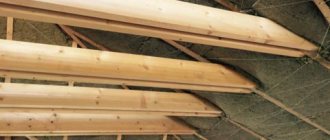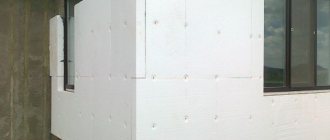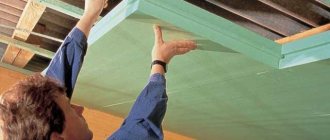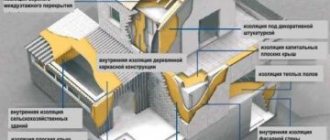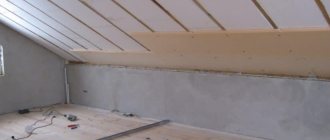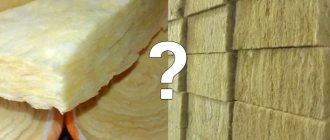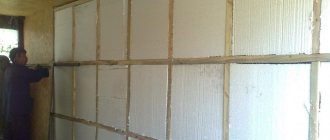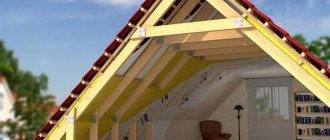As a rule, when converting an attic into a loft, additional living space appears. It is very convenient and beneficial in many ways. However, due to the increase in space in the house, this method will require further insulation of this room, for which one of the materials can serve as insulation, for example, polystyrene foam.
This choice is due to some special advantages of this material, in particular, such as complete resistance to moisture. In addition, the minimal price of polystyrene foam makes it more attractive to most homeowners. It is worth noting that insulating the attic with foam plastic must be carried out in stages and with maximum scrupulousness.
Insulation of a flat roof
If you have decided which insulation material to use for thermal insulation, and it is polystyrene foam, then before laying the material, you should prepare the surface - clean it of the previous backfill.
Then waterproofing is laid on the structure to prevent moisture penetration. If water gets on the insulation, it reduces its performance properties. After creating the waterproofing layer, foam boards are laid on it
Particular attention is paid to the tight fit of the combined elements, since large gaps and gaps should not be allowed. The service life of the created thermal protection depends on many factors, including how correctly the thickness of the attic or roof insulation is selected (read the article: “Thickness of roof insulation and insulation methods”).
One of the important points is the angle of the roof slope - the minimum slope cannot be less than 25 degrees, otherwise it will be impossible to ensure normal drainage of atmospheric precipitation from the roof and it will accumulate on its surface. Water should be allowed to flow freely into gutters. In this matter, the main thing is not to overdo it and not make too steep slopes on the roof.
Features of thermal insulation
Heat losses at home.
Insulation of the attic should prevent moisture, as well as heat and cold, from entering the upper floor from the street. The air near the ceiling will always be warmer, since cold air is always below, moving warm air up. In any case, heat loss from the wall and roof will vary greatly, even if the layers of materials are the same in thickness. In addition, due to changes in air temperature in the ceiling area, condensation may appear in the attic, which can spoil the performance of the structure.
The attic ceiling area is more susceptible to damage than other elements, for example, a certain temperature change that may cause condensation on the attic ceiling will not affect the walls in any way. Attic rooms are insulated according to much more stringent criteria than the rest of the building. Due to significant heat losses, proper insulation of the attic and walls can greatly reduce the cost of material and additions to it. In addition, modern thermal insulation methods can seriously increase the thermal insulation qualities of polystyrene foam, which means you can use less heating. Unsatisfactory insulation of various parts of the roof can lead to the appearance of large icicles, which, if they fall, can harm a person’s physical health. And if you try to knock down the icicles, the roof may be damaged.
To avoid the formation of condensation on the walls and ceiling in the attic, it is necessary to carry out a vapor barrier.
Well-made attic insulation will prevent icicles from appearing. Insulation is also necessary for the rafter system, otherwise the entire structure will not have the necessary properties and characteristics.
Before carrying out installation work, it should be taken into account that the amount of moisture in heated air varies greatly compared to cold air, because of this, the moisture in the air is released into the external environment. Waterproofing material, which is installed in almost all buildings, cannot remove moisture outside, which can cause various types of mold and fungal spores to appear on the walls
Drops of moisture that may form on the surface of the ceiling are not the result of leaks in the roof, but are simply formed due to too much condensation. Therefore, to avoid this unfavorable phenomenon, insulation must be carried out using a layer of vapor barrier material. Often it is located on top of the base. To remove moisture from the roof elements, you need to make an air cushion that will act as a kind of ventilation.
Attic insulation stages of work
Taking into account all of the above, you can begin to insulate the roof with your own hands using extruded polystyrene foam. Expanded polystyrene is a modern descendant of polystyrene foam, but it is better in strength and insulating characteristics. Sufficiently resistant to ultraviolet radiation. Produced in sheets of various sizes and colors.
Tools and materials
So, for the work you will need:
Tools for attic insulation.
- polystyrene foam boards of suitable thickness;
- reinforcing fiberglass mesh;
- diffusion membrane;
- stapler;
- adhesive composition;
- material for cladding (decorative plaster, lining, siding, etc.);
- wooden beam with a thickness of 3.5 to 4 cm;
- nails;
- hammer;
- saw;
- ax and other carpentry tools.
If the roof has already been completed according to all the canons, it must be waterproofed. Waterproofing is a film over the entire roof area, which is located directly under the roof itself. If it is missing, you need to do installation from the outside - you need to dismantle the roof and make a waterproofing coating.
First of all, you need to treat the wooden parts of the roof with antiseptic agents and allow them to soak well and dry. It is much better if the surface is treated with a fire retardant compound.
The next step is to install sheets of extruded polystyrene foam in the spaces between the roof rafters. To do this, you need to use special fastening products - staples or corners (which can be easily purchased at the store). In addition, they can be supported by thin slats attached across the rafters.
The gap between the waterproofing layer and the sheets should be from 20 to 50 cm: for better ventilation. It is necessary to install the sheets carefully so that there are no gaps between them and the rafters. If gaps do appear, you need to fill them with cut pieces from expanded polystyrene sheets or foam for installation. Most often, the thickness of the sheets is slightly less than the thickness of the “leg” of the rafters. If this is the case, the sheets are laid in more than one layer, and the fastening points (joints) of the sheets are made on different sides - to prevent cracks. Mounted and fixed sheets together with mounting rails must have a flat surface without protruding bumps or cracks.
Then a vapor barrier layer is installed. A special film is used for this. It can be ordinary or like a membrane: foil or perforated.
The film is mounted to the rafters using a stapler with a slight overlap of 10-15 cm. All joints are taped with a special tape. This is necessary so that the vapor barrier properties do not decrease in places of contact with the rafters. The tape should be glued transversely to the rafters. The tension of the film should be average, it is better to let it sag a little (up to 1 cm) in the center of the opening.
At the final phase, finishing is carried out - finishing materials are installed. It can be attached closely, adjacent to the vapor barrier, or it can be mounted on a thin lathing made of slats. If necessary, the surface is covered with wallpaper, varnish or paint.
At all phases of installation, we must not forget to provide high-quality insulation of engineering systems, if any. It is better to install electrical wiring in a non-flammable cable duct or corrugation, and use metal and asbestos materials for the chimney.
2.1Wall insulation
Thermal insulation of attic walls is necessary only in cases where the roof of the room does not reach the floor, and the surface of the walls is made in the form of partitions located around the perimeter.
On the surface of the walls made of wooden beams, you build a vertical frame for insulation with your own hands. The pitch of the frame should be 50-60 cm, ideally it should be equal to the width of the foam so that the insulation is located as tightly as possible in the cells.
The polystyrene foam is attached to the surface of the walls using an adhesive mixture, after which a vapor barrier film is installed, and the thermal insulation of the walls is sheathed with facing material - you can use OSB boards, plasterboard, or plywood.
You can decide for yourself what mixture will be used: there are now many different compositions on sale for this task.
Advantages and disadvantages of expanded polystyrene
Technical characteristics of expanded polystyrene boards.
The material is very durable, weakly compressible, which is why it can last a long time. They do not react in any way to chemistry and various kinds of biological manifestations, and because of its composition, neither insects, nor fungi and bacteria can appear in it. Do not allow polystyrene foam to come into contact with gasoline or solvent, as they can damage it. This is an excellent sound insulator, so extraneous sounds cannot enter the attic, insulated with polystyrene foam. Expanded polystyrene can be used both outside and indoors, which allows it to be a very valuable material for insulating an attic roof.
Its main disadvantage is that it is flammable, but this property can be reduced by adding fire retardants to the composition when preparing polystyrene foam. Once added, these substances will prevent the spread of fire.
Features of insulation with foam plastic boards
When, after laying foam boards, visible joints form between them, they must be sealed, for which polyurethane foam, which is produced in the form of polyurethane foam, is ideal. It is advisable to fill even the slightest gaps to prevent the formation of cold bridges.
When insulating an attic from the inside with polystyrene foam, for greater reliability, the slabs are attached to the surface using nails, dowels or adhesives (see: “Insulating an attic roof from the inside, how to avoid mistakes”). But glue, even high-quality one, loses its properties over time, but additional fastening with nails ensures the durability of the surface (read: “We do foam roof insulation correctly”).
Before insulating the attic with polystyrene foam, you need to purchase not only insulation, but also finishing materials. Often these are products made from natural wood. Sometimes a more expensive option is used: a special frame is created and slabs with a finishing layer are inserted into it.
Why wood cannot be insulated with polystyrene foam, example in the video:
Roofing pie composition
One of the options for multilayer thermal insulation with polystyrene foam is shown in the diagram below.
The use of thin sheets significantly complicates the process; this option turns out to be much more effective. Using three to four layers of expanded polystyrene, laid without using glue, has its advantages:
- Significantly more effective sound insulation;
- There is no risk of destruction of the attic insulation even with severe watering of the material;
- Complete absence of cold bridges.
In the diagram shown, the vapor barrier is laid on a wooden sheathing with a wind barrier and a ventilation gap.
Next come three layers of insulation, a vapor barrier and a final layer covering the ends of the rafters.
Calculation of the amount of foam
Before starting work, it is necessary to calculate the thickness of the attic insulation and, accordingly, determine the number of foam boards so that the entire area of the roof structure is covered. At the same time, you need to buy the material with a reserve, since an unforeseen situation may arise during the installation process. For example, when cutting foam plastic, the material needed to be given a certain shape, but a mistake was made. Other troubles are also possible. Therefore, if calculations have shown that at least 40 slabs will be required, it is advisable to purchase 50 before insulating the attic roof.
If the material remains, it will be useful in the future to replace elements that have become unusable. During transportation, foam plastic must be protected from mechanical damage and physical stress, and if it is transported in an open body, then also from precipitation.
Video description
In the video, a specialist talks about how to properly insulate a roof with polystyrene foam boards:
If the roof is a non-residential premises, then the rafter system is sheathed from the inside with used slab or sheet materials, or unedged boards. If the roof is part of the attic structure, then the cladding is carried out with plasterboard, clapboard, plywood, chipboard and OSB. Choose any one. It is clear that the skin is subsequently covered with a finishing finish.
And the second option is that the roof is in use. That is, it is covered with roofing material. From the inside of the attic, it looks like the same rafter legs. In principle, the insulation technology is the same, but there is one nuance. A vapor barrier membrane is laid over the rafters from the inside of the attic, as shown in the photo below. That is, the film wraps the rafters, and it is attached to them, but creates a cellular shape of the rafter system, leaving space for laying thermal insulation.
Vapor barrier film laid along the rafter system from inside the attic Source roomester.ru
Criterias of choice
Insulating an attic is a much more complex process than insulating floors, walls, windows and basements.
What matters here is the specificity of the sloping roof, which usually forms the attic, and the presence of sheathing - the insulation must be laid between the rafters and behind them, securely fixed and not change shape for a long time, despite the vertical location, it should not move away and sag.
It is also necessary to insulate the walls, ceilings, floors, gables - a fairly rigid material with good insulating properties is required.
If you choose between expanded polystyrene, polystyrene foam and mineral wool, you should choose the latter. Despite its higher cost, mineral wool has a whole range of useful properties that are superior to other heat-insulating materials.
It is environmentally friendly, retains its shape better than polystyrene foam and polystyrene foam, is not afraid of mice, unlike polystyrene foam, and unlike polystyrene foam, it is better ventilated and allows you to efficiently insulate the room, taking into account the need to live in it in the summer.
Fire safety
In practice, the fire safety of foam plastic is considered from two points - the danger of ignition of the material and the toxicity of combustion products. Foam plastic, although weakly, burns. Of course, it releases significantly less heat during combustion than other materials. For example, the thermal energy of polystyrene foam is at least three times less than the energy of wood. One might think that since polystyrene foam burns in the same way as other materials, there is no reason to refuse it. But in the case of constructing an attic, we get an object with an increased fire hazard.
After all, it’s one thing to insulate a brick wall from the outside with polystyrene foam, but a completely different fire situation if this material is in direct contact with wood. In addition, the attic is insulated from the inside, so the foam is separated from the living space by only a thin finishing material, which can also be easily flammable. An additional risk of ignition is caused by electrical wiring that is laid near the thermal insulation and is in contact with it. Even supporters of foam plastic insulation will confirm that the flammability of this material is very dependent on the “neighborhood”.
Considering that all the “neighbors” in an attic structure are fire hazards, it is better to abandon polystyrene foam. On average, only 18% of people die from direct fire during a fire, and the rest die through gas poisoning. In the event of even a small fire in a room with polymer materials, the number of victims will be large. To reduce the risk of poisoning in a fire, the thickness of the foam is of great importance. In some European countries there is a regulation that does not allow the use of foam thicker than 3.5 cm.
For the attic floor, a layer of at least 10 cm is required, therefore, the risk of poisoning is very high. If we add to all this the high temperature outside and a hot roof, the release of toxic gases will be maximum. Unfortunately, many turn a blind eye to the danger of foam plastic fire, since owners of private houses are not required to undergo a fire inspection. But, having chosen such a material for insulating the attic, it will be difficult to escape in a fire.
Stages of attic insulation from selection and calculation of insulation to installation
But if, when heated, the foam releases only styrene, then during combustion vapors of hydrogen cyanide and toluene diisocyanate are formed
(TDI), which are highly toxic.
Due to the danger to human health, polystyrene foam is prohibited for indoor use. Its only purpose is building facades
. And now we will answer the question, what is good about polystyrene foam as insulation.
Polystyrene foam is mostly made up of air. And, as you know, the air gap is an excellent insulation
. If you use foam plastic correctly for insulation, then you will not be afraid of any severe frosts. Heat loss through the walls of the building is reduced by 40%. But polystyrene foam will only “work” if used correctly.
Many companies and private contractors offer services for insulating facades with foam plastic. Unfortunately, failure to comply with the rules for using this material leads to the fact that insulation does not produce any results, moreover, mold forms in the apartment. And the problem here is the vapor permeability of the walls and poor hoods in the bathroom and kitchen
. Add plastic windows to everything, and problems with steam will lead to the development of fungus on the walls and ceiling.
A small part of the steam (from 3 to 5%) passes through the walls (be it a panel or brick house). Of course, hoods are responsible for most of the steam removal, but in many homes they work very poorly. Steam also passes through wooden windows, but not through plastic ones.
Please note that in many cases, after installing plastic windows in winter, condensation is observed on the glass. This is already evidence of poor performance of the hoods
Adding another layer of material to the wall, i.e. foam, which has low vapor permeability, leads to the formation of condensation on the outer surface of the wall.
The moisture under the foam doesn't go anywhere. As a result, the wet facade of the building not only does not heat, but also worsens the microclimate in the apartment
. This is where mold appears in the apartment, which is impossible to get rid of. What makes the situation worse is that moisture negatively affects the facade of the building and, under its influence, bricks and panels begin to collapse. In winter, condensation turns into ice, which tends to accumulate. As a result, the foam bends.
Failure to follow the rules for insulating a house with polystyrene foam leads to all these problems. Therefore, before deciding to use polystyrene foam, check the proper operation of the hoods in the house. Also , don’t skimp and install a vapor barrier on the inside
, which prevents steam from penetrating through the walls of the building.
There is no point in being afraid of polystyrene foam as a dangerous substance. If you follow simple rules, there will be no problems with steam and mold in an apartment or house insulated with foam plastic. But in winter it will be very warm and comfortable inside
.
Fragility of thermal insulation properties
This is due to the fact that to fix the polystyrene foam, polyurethane foam is used, which fills the cracks and fastens the sheets of material together.
This method is convenient, but not durable. After installation, a sealed layer of thermal insulation is indeed formed, since the foam easily flows into all the cracks and fills hard-to-reach places. The protective effect of the new thermal insulation is quite high.
But, again, the attic is a special room.
Its design is constantly susceptible to intense environmental influences. In summer, thermal insulation is exhausted by sudden temperature changes, when the roofing material practically heats up during the day and cools down at night. In winter, snow accumulates on the roof and ice freezes, and in rainy weather the humidity increases significantly.
Such conditions will certainly affect the condition of the joints between the foam sheets, which will dry out. Losing its solidity, the ball of foam insulation will become vulnerable, and heat losses will increase several times. As a result, the advantage of polystyrene foam not to lose its thermal insulation properties is inappropriate for attic rooms, since the main losses will occur through the destruction of the polyurethane foam.
